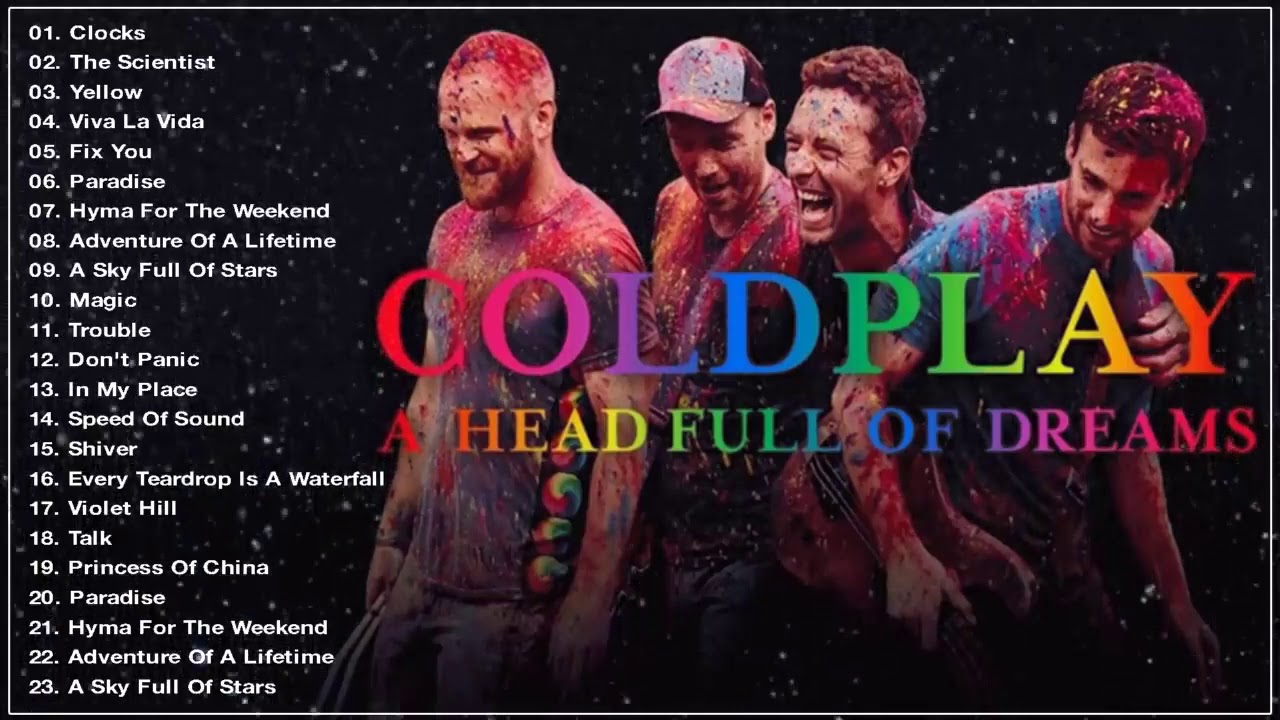Musics
Which Coldplay Album is the Best?
Coldplay has been a significant force in the music industry since their debut, blending emotive lyrics with melodic soundscapes. With multiple albums released over two decades, each offering a unique sonic experience, discerning which Coldplay album stands out can be an enthralling journey into their artistic evolution. The question of which Coldplay album is the best? invites exploration beyond mere rankings; it encourages an examination of themes, styles, and emotional resonance.
Exploring the Evolution of Coldplay’s Sound

Coldplay’s discography reflects a rich tapestry of musical experimentation and lyrical depth. Their early work, particularly Parachutes (2000), introduced audiences to an ethereal blend of alternative rock that resonated deeply with listeners seeking introspection. Tracks like “Yellow” and “Shiver” showcased lead singer Chris Martin’s vulnerable voice complemented by sweeping instrumentals, establishing a signature sound that many associate with the band.
The Emotive Allure of Parachutes

- Parachutes, Coldplay’s debut album, captivated listeners with its introspective nature and atmospheric soundscapes. The album’s opening track, “Don’t Panic,” sets the tone with its melancholic yet hopeful melodies, drawing listeners into a world of contemplation and personal reflection.
- The vulnerability in Chris Martin’s voice, combined with the band’s ability to craft emotionally resonant lyrics, is particularly evident in tracks like “Sparks” and “Trouble.” These songs delve into the complexities of human experience, touching on themes of isolation, uncertainty, and the search for connection.
- The album’s sonic palette, characterized by the delicate interplay of guitars, keyboards, and subtle percussive elements, creates a sense of intimacy and warmth that envelops the listener. This intimate quality allows the listener to truly immerse themselves in the emotive landscapes Coldplay has crafted.
Embracing Grander Concepts: XY and Viva La Vida
In contrast, albums like XY (2005) and Viva La Vida or Death and All His Friends (2008) marked a shift towards grander concepts and more intricate arrangements. The latter, featuring the iconic title track “Viva La Vida,” explores themes of mortality and revolution, demonstrating Coldplay’s willingness to tackle profound subjects while employing orchestral elements and world music influences.
- XY showcases Coldplay’s evolution, with tracks like “Fix You” and “Talk” exhibiting a more expansive sonic palette. The album delves into themes of personal growth, introspection, and the search for meaning, reflecting the band’s artistic maturation.
- “Viva La Vida or Death and All His Friends” further solidifies Coldplay’s ability to tackle ambitious thematic concepts. The album’s title track, with its sweeping orchestral arrangements and thought-provoking lyrics, explores the fleeting nature of power and the cyclical nature of human existence.
- This progression highlights how the band not only evolved musically but also deepened their lyrical narratives, inviting listeners into a more complex emotional landscape. The shift towards grander concepts and more intricate arrangements showcases Coldplay’s willingness to push the boundaries of their sound and engage with larger societal and philosophical themes.
Reflecting on the Themes of Connection and Isolation

As we delve deeper into Coldplay’s discography, it’s essential to consider the thematic contrasts present throughout their albums. For instance, Mylo Xyloto (2011) presents a vivid story of love in a dystopian setting, encapsulating the struggle between connection and isolation—a recurring motif in Coldplay’s work.
Mylo Xyloto: Navigating the Complexities of Love and Isolation
- The album’s vibrant colors in both sound and artwork embody hope amidst adversity, which resonates especially during turbulent times in society. Tracks like “Paradise” and “Charlie Brown” convey a sense of resilience and the human desire to find meaning in the face of challenges.
- The narrative arc of Mylo Xyloto explores the tension between the longing for connection and the reality of isolation, a theme that is particularly relevant in our increasingly digital and disconnected world. The album’s conceptual approach allows Coldplay to delve deeper into the emotional complexities of human relationships.
- Through the album’s storytelling, Coldplay invites listeners to reflect on their own experiences with love, loss, and the search for belonging. The band’s ability to craft emotive and relatable narratives through their music is a testament to their songwriting prowess.
A Head Full of Dreams: Celebrating Life and Collective Joy
On the other hand, A Head Full of Dreams (2015) serves as an optimistic celebration of life, weaving together influences from pop, dance, and even gospel. Its upbeat tracks encourage a sense of unity and joy, showcasing how Coldplay harnesses their platform to uplift and inspire audiences.
- The album’s vibrant and energetic sound, exemplified in tracks like “Adventure of a Lifetime” and “Hymn for the Weekend,” radiates a spirit of positivity and collective celebration. Coldplay’s willingness to incorporate diverse musical styles and collaborations with artists like Beyoncé further enhances the album’s uplifting and inclusive nature.
- A Head Full of Dreams serves as a counterpoint to the more introspective and thematically complex albums in Coldplay’s discography. By embracing a joyful and anthemic approach, the band demonstrates their ability to connect with audiences on a more universal level, offering a sense of shared experience and communal upliftment.
- This juxtaposition of darker themes in some albums versus the bright optimism in others raises fascinating questions about how art reflects human experience—whether through collective joy or individual sorrow. Coldplay’s versatility in navigating these emotional landscapes invites listeners to engage with their music on a profound level, finding resonance in the band’s ability to capture the full spectrum of human emotions.
The Impact of Collaborations and Experimentation

Notably, the evolution of Coldplay’s sound also stems from their willingness to collaborate with diverse artists. For example, Everyday Life (2019) features a rich tapestry of global influences and includes songs in various languages, symbolizing a commitment to inclusivity and cultural dialogue.
Everyday Life: Embracing Global Perspectives
- Everyday Life showcases Coldplay’s exploration of world music influences, incorporating elements of African, Middle Eastern, and South Asian sounds. This expansive approach to their sonic palette allows the band to engage with different cultural narratives and perspectives.
- The album’s multilingual tracks, such as “Eko” and “Arabesque,” demonstrate Coldplay’s desire to transcend linguistic boundaries and connect with a more diverse global audience. This artistic choice reflects a deeper commitment to inclusivity and the recognition that music can serve as a universal language.
- By stepping outside their comfort zone, Coldplay embodies a spirit of curiosity and exploration, which may resonate differently among listeners based on their own backgrounds and experiences. This adaptability invites us to consider how Coldplay’s collaborations, such as those with Beyoncé or Rihanna, have both expanded their sound and reached new audiences.
The Power of Collaboration and Experimentation
Coldplay’s willingness to collaborate with other artists has been a hallmark of their career, often resulting in innovative and boundary-pushing musical ventures. These collaborations have not only expanded the band’s sonic palette but have also allowed them to bridge gaps between genres and cultures.
- Tracks like “Princess of China,” featuring Rihanna, and “Hymn for the Weekend,” with Beyoncé, showcase Coldplay’s ability to seamlessly integrate diverse artistic voices and influences into their own distinctive sound. These collaborations invite listeners to explore the intersections of different musical styles and perspectives.
- Coldplay’s experimental approach to their craft is further exemplified in their use of unconventional recording techniques and the incorporation of electronic elements. Albums like Mylo Xyloto and A Head Full of Dreams demonstrate the band’s openness to pushing the boundaries of their sound, blending organic instrumentation with synthetic textures to create unique and immersive sonic experiences.
- This spirit of curiosity and innovation prompts a reflection on the power of music as a universal language that transcends boundaries and bridges gaps between cultures. Coldplay’s willingness to explore and collaborate challenges listeners to engage with their art on a deeper level, fostering a greater appreciation for the transformative potential of music.
Personal Connections: What Makes an Album The Best?

Ultimately, the question of which Coldplay album reigns supreme often boils down to personal connection rather than objective criteria. For some, the raw emotion of Parachutes may hold nostalgic value, while others might find the eclectic sounds of Mylo Xyloto or the celebratory nature of A Head Full of Dreams more appealing.
The Subjective Nature of Musical Preferences
- Each listener’s life experiences shape their perceptions of these albums, making the quest for a definitive answer subjective and deeply personal. Factors such as personal history, emotional resonance, and individual musical tastes all contribute to the way we engage with and appreciate Coldplay’s discography.
- Considering this dynamic, one might ask: Is it the sound, the lyrics, or the memories associated with the music that makes an album stand out? Perhaps it’s all three intertwined, suggesting that music forms a unique bond with its audience—one that evolves just as the artists themselves do.
- The diversity of Coldplay’s musical offerings and the varied thematic explorations within their albums further emphasize the subjective nature of musical preferences. What may resonate deeply with one listener may leave another indifferent, highlighting the deeply personal and contextual nature of the “best” Coldplay album.
Embracing the Diversity of Perspectives
Recognizing the subjective nature of this debate invites us to celebrate the diversity of perspectives and experiences that Coldplay’s music can evoke. Rather than seeking a definitive answer, we can embrace the richness of the band’s discography and the ways in which it speaks to different individuals.
- By acknowledging the personal connections that listeners form with Coldplay’s music, we can gain a deeper understanding of the transformative power of art and the unique ways in which it resonates with the human experience.
- Engaging with Coldplay’s discography is akin to embarking on a musical odyssey, where every album serves as a chapter in the story of human emotion, creativity, and connection. The “best” Coldplay album ultimately becomes a reflection of the listener’s own journey, making the exploration of their music a deeply personal and rewarding experience.
In the end, the question of which Coldplay album is the best continues to invite passionate discussions and varied perspectives. Coldplay’s discography represents a rich tapestry of musical evolution, thematic exploration, and personal connection, making it challenging to definitively crown a single album as the undisputed masterpiece.
As listeners, we are invited to immerse ourselves in the band’s artistic journey, embracing the diversity of their sound and the profound themes they continue to explore. Whether it’s the raw emotive power of Parachutes, the conceptual grandeur of Viva La Vida, or the uplifting celebration of A Head Full of Dreams, each album offers a unique opportunity to connect with the human experience in all its complexity.
Ultimately, the “best” Coldplay album is not a singular, objective truth, but rather a deeply personal and subjective exploration of how music can captivate, inspire, and transform the human spirit. By engaging with Coldplay’s discography and reflecting on our own connections to their art, we can gain a richer understanding of the enduring impact of this remarkable band.
